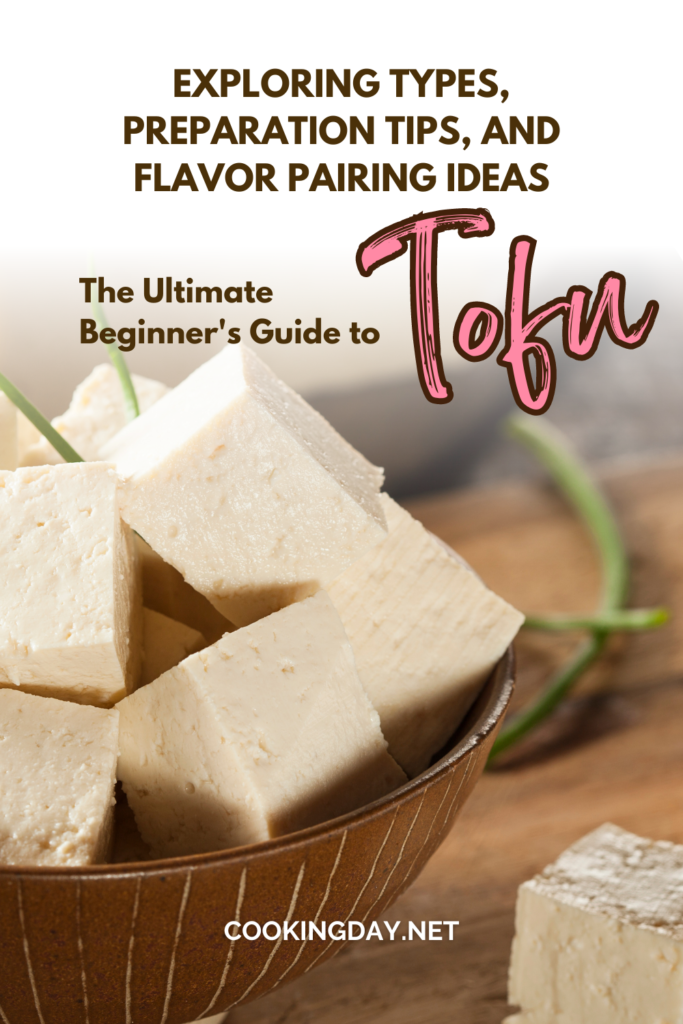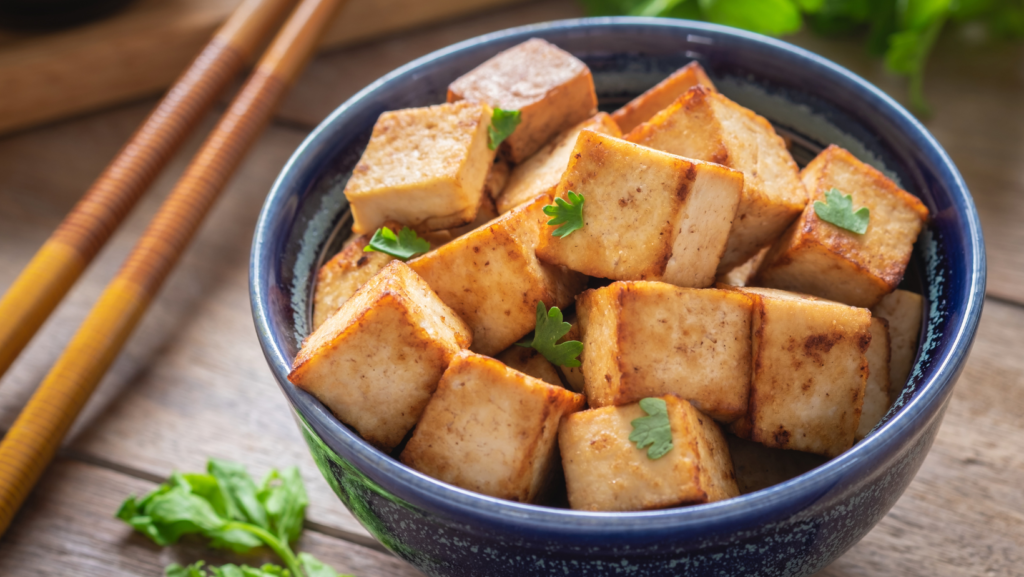Some links on this page are affiliate links. This means we may earn a commission at no additional cost to you if you click through and make a purchase, you can check our Affiliate Disclosure. Thank you for your support!
Tofu, a staple in many kitchens worldwide, is a versatile ingredient and a powerhouse of nutrition. Let’s dive into what tofu is and explore its health benefits. 🌱
What is Tofu?
Soybeans are the source of tofu, also referred to as bean curd. Similar to how traditional cheesemakers make cheese from milk, tofu makers curdle fresh soymilk, press it into a solid block, and then let it cool.
Here’s a simple breakdown of the tofu-making process:
- Soak soybeans in water and then blend them to create a milky liquid.
- Boil this liquid and then strain it to produce soymilk.
- Add a coagulant (like magnesium chloride or calcium sulfate) to the soymilk.
- Once curdled, press the curds into molds to form tofu blocks.
It is incredibly versatile in the kitchen. It can take on many textures and flavors, making it a fantastic food for both savory and sweet dishes. You’ll find it in various forms, ranging from soft and silky to firm and chewy.

The Health Benefits of Tofu
Tofu isn’t just tasty; it’s also packed with nutritional benefits! Here are some of the key health perks:
- Rich in Protein: For vegetarians and vegans, it is an excellent option because it is a fantastic source of plant-based protein.
- Low in Calories: Despite being rich in nutrients, it is relatively low in calories, which can be beneficial for weight management.
- Heart Healthy: It contains isoflavones, linked to a reduced risk of heart disease.
- Bone Health: It can help keep bones strong because it has a lot of calcium and magnesium.
- Rich in Minerals and Vitamins: It provides iron, manganese, selenium, and several essential vitamins.
So, whether you’re a tofu enthusiast or just getting started, there’s a lot to love about this soy-based wonder. In the next sections, we’ll explore the different types and how to prepare and pair them for delicious meals. Stay tuned! 🍲
Exploring Different Types
Tofu comes in several types, each with its own unique texture and best uses in cooking. Let’s explore the different types and how to use them to create delicious dishes. 🥢
Silken Tofu: Characteristics and Uses
As the name suggests, silken tofu is smooth and creamy, almost like custard. Here’s what you need to know about it:
- Texture: Silken tofu is delicate and can fall apart easily. It’s best used in dishes where it doesn’t need to hold its shape.
- Uses: It’s perfect for blending into smoothies, making desserts like vegan cheesecake, or in soups like miso soup.
Firm and Extra-Firm Tofu: Best Practices for Cooking
Firm and extra-firm tofu are the go-to choices for most tofu recipes. They hold their shape well and are great for various cooking methods.
- Preparing: Before cooking, press the tofu to remove excess water. It helps it absorb flavors better and get a crispier texture when cooked.
- Cooking Tips: You can marinate it, bake it, stir-fry, or grill it. Firm tofu is great for scrambling, while extra-firm makes crispy tofu bites or grilling.
Comparing Soft and Medium Tofu
Soft and medium tofu fall between silken and firm tofu in texture. They’re more versatile than silken tofu but still need gentle handling.
- Soft Tofu: It’s slightly firmer than silken and works well in gently simmered soups and stews.
- Medium Tofu: This type can be carefully stir-fried or used in dishes like Mapo Tofu, which retains some softness but doesn’t break apart easily.
Remember, the type you choose can make or break your dish. So, experiment with these varieties and discover the wonderful world of tofu-based recipes! 🍲
Preparing, Tips and Techniques
Getting it ready for your favorite dishes is an art. With this adaptable ingredient, you can make amazing things using a few basic trade tricks. Now let’s examine the specifics! 👳
Pressing Tofu: Why and How
Pressing tofu is all about removing excess water, and here’s why and how you do it:
Why Press Tofu
Tofu packed in water can be quite spongy. Pressing it helps remove excess moisture, allowing the tofu to absorb marinades better and giving it a better texture when cooked.
How to Press Tofu
- Wrap the tofu block with paper towels or a clean kitchen towel.
- Place it on a plate and put a heavy object (like a skillet or a can) on top.
- Let it sit for about 15-30 minutes.
- Change the towels if they get too wet.
Marinating Tofu for Flavor Enhancement
Marinating is key to adding flavor to it. Since tofu is like a blank canvas, it soaks up any flavors you introduce.
- Simple Marinade Ideas: Use soy sauce, garlic, ginger, or your favorite herbs and spices. For a sweeter touch, add a bit of maple syrup or agave.
- Marinating Time: For best results, marinate tofu for at least 30 minutes, or overnight for more intense flavor.
Cooking Techniques: Grilling, Baking, Stir-Frying
Now that your tofu is prepped and marinated, it’s time to cook it! Here are some popular methods:
- Grilling: Perfect for getting that smoky flavor. Brush the tofu with oil and grill it for 2-3 minutes on each side.
- Baking: Great for a hands-off approach. Bake marinated tofu at 400°F (200°C) for 20-30 minutes, flipping halfway.
- Stir-Frying: Ideal for a quick meal. Cook marinated tofu over medium-high heat until all sides are golden brown.
Each method brings out a different texture and flavor in tofu, making it a versatile ingredient for various dishes. So, grab some of it and start experimenting with these techniques! 🥘
Flavor Pairing
Tofu is like a sponge for flavors, making it a dream ingredient for creative cooks. The right combination of herbs, spices, sauces, and sides can elevate your tofu dishes. Let’s explore the best flavor pairings for tofu! 🌿🍲
Herbs and Spices that Complement Tofu
To bring out the best in tofu, start with these herbs and spices:
- Garlic and Ginger: These aromatic favorites add a punch of flavor, perfect for stir-fries and marinades.
- Turmeric: Adds a beautiful golden color and a subtle earthy taste.
- Cumin and Coriander: Great for a hint of warmth and depth, especially in tofu curries.
- Basil and Oregano: Ideal for Italian-style tofu dishes, adding a fresh and herby note.
- Chili Flakes or Paprika: For those who like a bit of heat in their food.
Experiment with these to find your favorite combinations!
Sauces and Marinades for Tofu Dishes
Sauces and marinades can transform tofu from bland to grand. Here are some ideas:
- Soy Sauce-Based Marinades: For a traditional Asian taste, combine soy sauce with sesame oil and honey or agave as a sweetener.
- BBQ Sauce: Try marinating tofu in your favorite BBQ sauce for a smoky, tangy twist.
- Peanut Sauce: Combine peanut butter, soy sauce, and a bit of lime juice for a rich, nutty flavor.
- Teriyaki Sauce: Great for a sweet and savory touch.
Feel free to get creative and make your unique blends!
Pairing Tofu with Vegetables and Grains
Tofu plays well with a wide range of vegetables and grains:
- Leafy Greens: Spinach, kale, and bok choy add nutrition and color to tofu dishes.
- Colorful Veggies: Bell peppers, carrots, and eggplants bring sweetness and crunch.
- Grains: Serve tofu over rice, quinoa, or noodles for a hearty meal.
- Beans and Legumes: Chickpeas, lentils, and black beans can be great companions for tofu in stews and salads.
Combining tofu with these wholesome ingredients creates balanced, flavorful, and nutritious meals. So, go ahead and mix and match to find your favorite tofu pairings! 🥗🍜
Tofu Recipes for Beginners
Ready to start cooking with tofu? Here are three simple yet delicious recipes that are perfect for beginners. These dishes showcase tofu’s versatility and are sure to impress. Let’s get cooking! 👩🍳👨🍳
Simple Tofu Stir-Fry Recipe
Stir-frying is a quick and easy way to enjoy tofu. Here’s a basic recipe to get you started:
Ingredients:
- Firm tofu, pressed and cubed
- Assorted vegetables (like bell peppers, broccoli, and carrots)
- Soy sauce
- Garlic and ginger, minced
- Vegetable oil
- Cooked rice or noodles, for serving
Steps:
- Heat the Oil: Place a large pan over medium high heat with a small amount of vegetable oil.
- Cook the Tofu: Add tofu cubes and stir-fry until golden brown on all sides.
- Add Veggies: Toss in your veggies and cook until tender but still crisp.
- Season: Add minced garlic and ginger, then pour in soy sauce to taste. Stir everything to combine.
- Serve: Serve your stir-fry over rice or noodles. Enjoy!
Baked Tofu with Seasonal Vegetables
Baking tofu is fuss-free and gives it a wonderful texture.
Ingredients:
- Firm or extra-firm tofu, pressed and sliced
- Seasonal vegetables (like zucchini, squash, and cherry tomatoes)
- Olive oil
- Your choice of herbs and spices
Steps:
- Preheat Oven: Set your oven to 400°F (200°C).
- To season the tofu and vegetables, mix them with olive oil, any herbs, and spices you like.
- Bake: Spread everything out on a baking sheet. Bake for 20-30 minutes until the tofu is crispy and vegetables are roasted.
- Serve: Enjoy your baked tofu and veggies hot!
Grilled Tofu Skewers with a Tangy Glaze
Grilled tofu skewers are perfect for a tasty and healthy barbecue.
Ingredients:
- Extra-firm tofu, pressed and cubed
- Your choice of vegetables for skewers (like onions, bell peppers, and mushrooms)
- For the glaze: soy sauce, honey, garlic, and lime juice
Steps:
- Prepare Glaze: Mix soy sauce, honey, minced garlic, and lime juice in a bowl.
- Assemble Skewers: Thread tofu and vegetables onto skewers.
- Grill: Grill the skewers, brushing with the glaze until tofu is nicely charred and veggies are cooked.
- Serve: Enjoy your skewers with a side of rice or salad!
Storing and Preserving Tofu
Proper storage is key to keeping your tofu fresh and tasty. Whether you’re refrigerating or freezing, here are some tips to help you make the most of your tofu. 🧊🍱
ALSO READ: Discovering the Delights of Filipino Adobo: A Culinary Journey
Tips for Refrigerating and Freezing Tofu
It can be tricky to store if you’re unfamiliar with the best practices. Here’s how to do it right:
Refrigerating
- Unopened Tofu: Keep it in its original packaging until you can use it.
- Opened Tofu: Transfer leftover tofu to an airtight container. Cover it with fresh water and change this water daily. This way, it stays fresh for about 4-5 days.
- Marinated or Cooked Tofu: Store in an airtight container for up to a week.
Freezing Tofu
Why Freeze Tofu: Freezing it changes its texture, making it more sponge-like and ideal for absorbing marinades.
How to Freeze:
- To get rid of extra water, it can be drained and pressed.
- Cut into slices or cubes, depending on your preference.
- Place it on a baking sheet, not touching, and freeze until solid.
- Once it is frozen, transfer to a freezer-safe bag or container. It can be stored for up to 5 months.
Shelf Life of Different Tofu Types
Different types of tofu have slightly different shelf lives:
- Silken Tofu: This delicate tofu should be used within a few days of opening. It doesn’t freeze well due to its high water content.
- Firm and Extra-Firm Tofu: These are more resilient and can last in the fridge for about a week and up to 5 months in the freezer.
- Medium Tofu: Falls somewhere between silken and firm tofu regarding shelf life. It’s best used within 4-5 days of opening.
Remember, always check tofu for signs of spoilage like a sour smell or changes in color before using. Following these storage tips’ll ensure your tofu stays fresh and delicious for as long as possible! 📆🥢
ALSO READ: Rajma: The Heartwarming North Indian Kidney Bean Stew
To Wrap Up
As we reach the end of our tofu journey, let’s recap the amazing benefits and uses of it, and encourage you to experiment with this versatile ingredient in your kitchen. 🌟
Summary of Tofu Benefits and Uses
Tofu, a humble soy product, is delicious and packed with health benefits and culinary possibilities. Here’s a quick summary:
- Nutritional Powerhouse: It is rich in protein and contains essential amino acids. It’s also a great iron, calcium, and other minerals source.
- Versatility in Cooking: Whether it’s silken, firm, or extra-firm, It can be used in many dishes. From stir-fries and soups to grills and desserts, it adapts to various cooking styles and flavors.
- Diet-Friendly: Ideal for vegetarian, vegan, and health-conscious diets, it is low in calories and can be a meat alternative.
- Easy to Prepare: As we’ve seen, it can be pressed, marinated, baked, grilled, and more. It’s a fantastic ingredient for both beginners and experienced cooks.
ALSO READ: Exploring Filipino Flavors: Bicol Express – A Spicy and Creamy Pork Dish
Encouraging Experimentation with Tofu
Now that you’re equipped with the knowledge about tofu, it’s time to get creative!
- Try New Recipes: Use our shared recipes as a starting point and then branch out. Remember, tofu is incredibly forgiving and adaptable.
- Mix and Match Flavors: Don’t be afraid to experiment with different herbs, spices, and marinades. It’s neutral flavor makes it a perfect canvas for culinary creativity.
- Share Your Creations: Cooking is more fun when you share it with others. Whether it’s a family dinner or a post on social media, let everyone know about your tofu adventures.
In conclusion, tofu is more than just a soy-based product; it’s a versatile, nutritious, and delicious food that deserves a spot in everyone’s kitchen. So, grab some tofu and start experimenting – the possibilities are endless! 🍴🌈
ALSO READ: Elevate Your Meals: A Power-Packed Guide to Seasonal Ingredients




